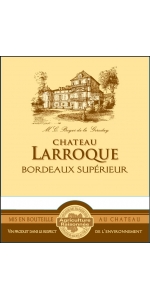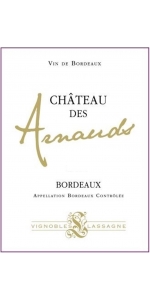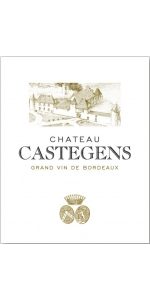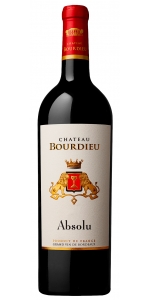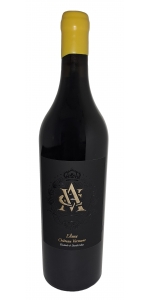Chateau Plaisance Bordeaux Superieur 2006
| Country: | France |
| Region: | Bordeaux |
| Winery: | Plaisance |
| Grape Types: | Cabernet Sauvignon Merlot |
| Vintage: | 2006 |
| Bottle Size: | 750 ml |
Chateau Larroque Bordeaux Superieur Rouge is a blend of 51% Merlot and 49% Cabernet Sauvignon.
Nose : Red fruits, almond and hazelnut, with a faint vanilla aroma.
Mouth : The silky, velvety attack reveals a pleasant, concentrated and well structured wine. It offers a combination of fruits pastes’ flavors, licorice and toasted notes, and an elegant finish.
The 60-hectare vineyard was rapidly replanted and the château building, which dates from 1348, was restored.
Our family now produces three different-colored wines there: red, white and rosé.
Fermentation : Alcoholic fermentation in thermo-regulated stainless steel vats at around 26°C / 78°F then a gentle vatting for 3 weeks at 30°C / 86°F. Running off and pressing,separation of the press and free-run juice. Malolactic fermentation in thermo-regulated stainless steel vats at around 18°C / 64°F
- 2017 Decanter World Wine Awards Decanter 95 Points
Color : Dark garnet hue
Marie-Christine, the daughter of Henri Ducourt, purchased this prestigious left-bank property in 1979, which lies on the border of the Graves appellation.
Grown on loamy-clay soil.
Macération : Pre-fermentation cold maceration of 24 to 48 hours
Enjoy this wine with charcuterie, roasted meats, BBQ, cheeses.
Chateau Arnauds des Bordeaux Rouge is made from 100% Merlot.
The wine shows a deep red purple color and intense aromas of black fruits (blackcurrant, black cherry) with hints of liquorice. Very fruity and well-balanced. It is powerful and well structured in the mouth with round and silky tannins, ripe flavors of black fruits. Strong and a slightly spicy finish.
Grapes are coming from 30 year old vines planted on gravelly soils.
The land benefits from sun exposure, warmth and humidity that are strong assets for the vine culture.
The wine pairs well with game meat and beef on the grill.
Chateau Castegens Cotes de Bordeaux Castillon is made from 80% Merlot, 18% Cabernet Franc and 2% Cabernet Sauvignon.
The wine boasts an intense, deep and lively red color. The nose offers black fruit, blackberry, cigar box, licorice, some delicate and integrated oak flavors as well. The mouth is full of fruit flavors, spice and fine toasty flavors. The structure is rich, but the tannins are well integrated already. The finish is long and a slight mintiness give the wine a great length and some purity.
Pairs great with meat and vegetables on the grill.
Chateau Bourdieu Absolu Blaye Cotes de Bordeaux is made from 79% merlot, 17% Cabernet Sauvignon, 4% Malbec.
When Luc Schweitzer was joined by his two sons Richard and Ludovic at the estate, he wanted to embrace this new chapter in the family history and launched in 2016 a special cuvée from Château Bourdieu called "Absolu". This top-of-the-range cuvée is the best of what their terroir has to offer. The 35 year-old facing south vines benefit from a meticulous care: regular maintenance of the soil, yield control, manual leaf stripping, sorting of the berries - all practices that ensure the quality of this great Bordeaux wine.
A deep garnet color with magnificent purple highlights. The nose is intense and full, revealing notes of ripe black fruits and subtle hints of vanilla and roasted coffee. Great structure with finesse and tannic density that brings depth and length to the mouth. The aromatic purity of the perfectly ripened grape varieties is magnified by the complex and subtle oak flavors.
Pair: Rib of grilled beef and tournedos Rossini - butter pan-fried beef filet served on a crouton, and topped with a hot slice of fresh foie gras.
Review:
"A rich, opulent wine, this is full of dark tannins and powerful fruit. It's a big wine, with licorice and dense wood flavors that give a smoky character and reflect some serious extraction. The wine needs to smooth out to showcase its concentrated richness. Drink from 2024. - Roger VOSS"
- Wine Enthusiast (May 2021), 91 pts
All older vintage wines have been purchased from a single collectors cellar. Pictures can be requested before shipment.
Chateau Vermont L'Ame Grand Vin de Bordeaux is made from 40% Merlot, 30% Cabernet Franc and 30% Petit Verdot.
L'AME de Vermont represents the culmination of 10 years of dedicated work, derived from select grapes of Chateau Vermont's best parcels, chiseled to be the ultimate extraction of their terroir and Spirit. This cuvée is the Winemaker's soul. It is a reflection of the requirements, precise work and desire to achieve perfection.
A rare and confidential wine, vinified and matured in new oak barrels. Fine wine, elegant and well-balanced, with vanilla notes coming from the oak aging and subtle scents of ripe black and red fruits. A beautiful structure and great aging potential.
Chateau Plaisance Bordeaux Superieur is made from 70 % Merlot, 20 % Cabernet Sauvignon,10 % Petit Verdot. The grapes are hand-harvested at full maturity.
Temperature controlled fermentation in stainless steel vats between 28 degrees - 30 degrees C. Careful selection of the vats for bottling: they bottle only 50 to 75% of the annual production, selling the rest to nogociant.
Aging in oak casks (20% to 30% new barrels every year). A deep purple color, powerful and elegant wine with a rich nose, fruit aromas. Well-balanced, powerful yet refined on the palate with present but mellow woody tannins, fruit flavors.
The Chateau Plaisance Estate
Chateau Plaisance is located in the Medoc area, at the border of the Margaux appellation, overlooking the Gironde River. The average annual production is 60,000 bottles.
The construction of the Chateau Plaisance itself dates back to the 1780s, but its vineyards are far older, as can be seen on the 1753 map of the estate which can be found in the departmental archives of the Gironde.
This neoclassical "folie bordelaise" with its exterior double-helix staircase is now a listed historical monument. It still bears on its pediment the initials of its first owner, Jean Cavalier, and continues to be admired by lovers of 18th-century art. The architect of this monument was François Lhôte who was very active throughout the Bordelais.
Today, thanks to the painstaking attention of its owners, Chateau Plaisance has been reborn:
"We wanted to give the wines of Chateau Plaisance estate a reputation worthy of the prestigious architecture of the building itself. That's why the vineyards we tend, the wines we produce in our chais, the thousands of bottles we offer wine lovers, everything we do must show our ongoing concern for irreproachable quality."
The Chateau Plaisance Vineyard
Back in 1991, Jean-Louis and Isabelle Chollet began to buy up land in order to reconstitute the vineyards of the Châaeau Plaisance estate, located at the edge of the Margaux appellation d'origine controlee, on these famous palud alluvial soils, a terroir that has regained its former glory.
Overlooking the Garonne River, ten of the thirteen hectares of the estate, forming a single block, are now planted with 70% merlot, 20% cabernet-sauvignon, and 10% petit-verdot grapes. We have chosen to plant at a density of 5000 vines to the hectare to ensure a better concentration of our wines and to ensure an average yield of about 50 hectolitres per hectare.
- back
Franz Prager, co-founder of the Vinea Wachau, had already earned a reputation for his wines when Toni Bodenstein married into the family. Bodenstein’s passion for biodiversity and old terraces, coupled with brilliant winemaking, places Prager in the highest echelon of Austrian producers.
Smaragd is a designation of ripeness for dry wines used exclusively by members of the Vinea Wachau. The wines must have minimum alcohol of 12.5%. The grapes are hand-harvested, typically in October and November, and are sent directly to press where they spontaneously ferment in stainless-steel tanks.
Klaus sits adjacent to Achleiten and is one of the Wachau’s most famous vineyards for Riesling. The vineyard is incredibly steep with a gradient of 77% at its steepest point. The southeast-facing terraced vineyard of dark migmatite-amphibolite and paragneiss produces a tightly wound and powerful wine. The parcel belonging to Toni Bodenstein was planted in 1952.
Tasting Notes:
Austrian Riesling is often defined by elevated levels of dry extract thanks to a lengthy ripening period and freshness due to dramatic temperature swings between day and night. “Klaus is not a charming Riesling,” says Toni Bodenstein with a wink. Klaus is Prager’s most assertive and robust Riesling.
Food Pairing
Riesling’s high acidity makes it one of the most versatile wines at the table. Riesling can be used to cut the fattiness of foods such as pork or sausages and can tame some saltiness. Conversely, it can highlight foods such as fish or vegetables in the same way a squeeze of lemon or a vinaigrette might.
Review:
Superbly cool, restrained and refined, this austere, beautiful dry riesling is a slow-burn masterpiece that's only just beginning to reveal its complex white-peach, white-tea, wild-herb and dark-berry character. Super-long and mineral finish. Drink or hold.
-James Suckling 97 Points
A balanced and memorable Chardonnay that starts with aromas of orangeblossom, Asian pear, crème fraiche, peaches and chamomile, complemented bynotes of toffee, honeysuckle, and graham cracker. On the palate, flavors of greenapple, Meyer lemon and stonefruit are finished with notes of tangerine and vanilla.This Chardonnay is smooth, creamy and balanced with a lingering acidity and a longfinish. This is the perfect wine to pair with a brie or gouda cheese plate drizzled withlocal honey and hazelnut.
Review:
Fruit is sourced primarily from the southern part of Napa Valley, and aged five months in French oak. With its billowy mouthfeel, the liquid seemingly floats above the palate. Lemon curd, daffodil, cinnamon toast, and creamy vanilla sandalwood are delicious and generous flavors. This is approachable luxury. - The Tasting Panel, July/August 2025
-Tasting Panel/Somm Journal 92 Points


